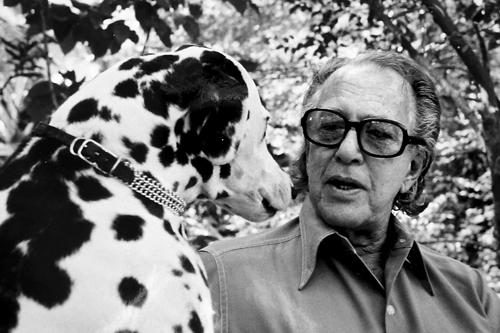Let’s talk Bawa, the man, the genius

Geoffrey Bawa at Lunuganga - pic courtesy Geoffrey Bawa Trust
Legendary architect Geoffrey Bawa was famously silent about his work and there are only a handful of records where he opens up about his influences, routines and practice. He also rarely saved material like correspondence or sketches. The Geoffrey Bawa Oral History Programme initiated in 2018 under the Bawa 100 Centenary Programme, is part of the Geoffrey Bawa Trust’s efforts to fill this void by collecting the memories, stories and experiences of Bawa’s friends, clients and colleagues.
The series of informal conversations with Bawa’s former friends, colleagues and collaborators, recorded in audio and video formats, seeks to reflect on the nature of Bawa’s architectural practice, his methods, his personality and the many important collaborators who enabled and enriched the work, thus enabling deeper study of Bawa’s work.
The conversations feature Amila de Mel, Anura Ratnavibushana, Channa Daswatte, David Robson, Deepal Wickremasinghe, Dilshan Ferdinando, Iranganie Serasinghe, Ismeth Raheem, Laki Senanayake, Michael Snelling, Philip Fowler, Pierre Pringiers, Saskia Pintelon, Suhanya Raffel and Sunethra Bandaranaike.
The project was launched with recollections from Sunethra Bandaranaike, a former Chairperson and Trustee of the Geoffrey Bawa and Lunuganga Trusts. One of Bawa’s clients (he designed her famous Horagolla Stables home), she was also a close friend. She recounted the first time she met Bawa, their collaborative creative vision, and the deep friendship they shared over many decades. Her standout recollection was Bawa’s ability to envision a project in its entirety when he first visited a site, be it for the refurbishment of the Horagolla Stables or the Kandalama Hotel.
“And he was very modest, amazingly modest. Never once have I heard him praising anything he had done; never. Someone else would say that to him and I’m sure he appreciated that, which was a remarkable quality in the man. He must have thought ‘I am creating wonderful things. I know that. It is not for me to say. It is for others to see it and come to their own conclusion.’ That was a wonderful quality of Geoffrey.”
Next in the series is architect Anura Rathnavibhushana, who worked with Bawa at Edwards, Reid & Begg during the ‘60s and ‘70s, leaving to set up his own practice in the ‘80s although he continued to maintain his close connection with Bawa. In the episode Anura runs through his memories of Bawa as a mentor, detailing the thrill of working on projects such as the Osaka Expo Pavilion of 1970; and the Steel Corporation Building in Oruwala of 1969. He also touches on the experimental process of designing chairs and light fittings to complement the architectural spaces the firm designed.
“He was a master of the English language, succinct; aphorisms, and epigrams and all that. And he would come out with that at once and that’s all he would say, you worked out what it meant.”
In the episode from artist Laki Senanayake, he recalls his career at Edwards, Reid and Begg where he started at age 18, leaving the firm a few years later to collaborate with Geoffrey’s dear friend and client Ena de Silva. Laki and Geoffrey continued to work together on several key projects with Laki designing large-scale murals and reliefs for Geoffrey’s Triton and Neptune Hotels. He also designed the chandelier for the Sri Lankan Parliament Chamber — which was inspired by an earlier drawing of a double coconut tree at the Peradeniya Botanical Gardens, as well as the larger than life sculptural staircase at Lighthouse Hotel in Galle. Laki spoke about the influence of music on his work, the time he spent with Ena de Silva, and Geoffrey’s avid collection of his art.
“He used to come on weekends and when he was there (at Lunuganga) - I was already painting, he was delighted. He liked painting anywhere. His houses are full of —both Lunuganga and Colombo — are full of artworks. You look — I think there are more of my art works than anything else in there. But he only bought two, [laughter] all the rest were given to him by me for free.”
Belgian artist Saskia Pintelon and her partner Pierre Pringiers, have spent many years living in properties designed by Geoffrey Bawa. Reminiscing about their time in the Ena de Silva House, they also recalled life at Cinnamon Hill with Geoffrey Bawa as their neighbour. Many of Saskia’s works are in the Geoffrey Bawa Collection and can be seen at Lunuganga and Number 11; Geoffrey’s two homes on the island.
“Beauty is what we talked about, you know. Art was another thing, of course he loved art, and art and beauty are much connected. People talking about art very often talk about famous art and things like that — they throw names. But what we were talking about is real beauty and about real, how would I say it — the passion part. This is what I felt. And basically with Geoffrey, it was fun.”
The Oral History Programme hopes to be a resource for architects, designers, scholars and any others who seek to understand better the life of one of Sri Lanka’s most important architects. Access the oral histories on SoundCloud or Apple Podcasts (iTunes) under the Geoffrey Bawa Trust channel.
The Trust invites submissions of potential historians and anecdotes to archives@gbtrust.net.



